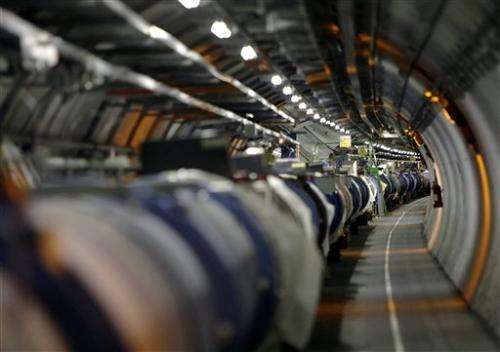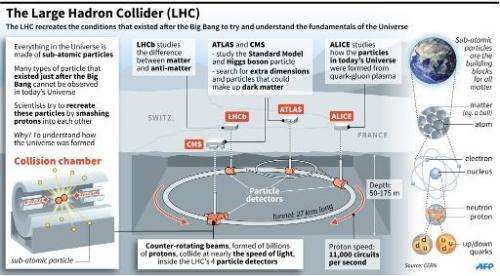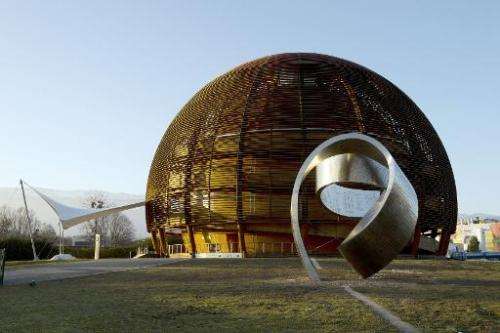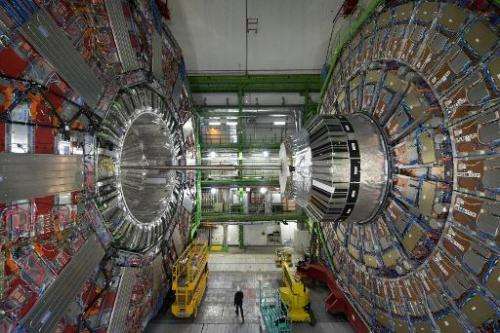CERN's revamped particle smasher ready to push physics into unknown

Europe's physics lab CERN said Thursday it had begun tests in preparation for rebooting the world's biggest particle collider and trying to uncover new particles that could alter our understanding of the Universe.
"We are really excited, because we are entering a new phase," CERN director general Rolf Heuer told reporters in Geneva.
CERN's Large Hadron Collider (LHC) went offline in February 2013 for a massive overhaul after identifying what is believed to be the Higgs boson, the long-sought maker of mass theorised in the 1960s.
The giant lab, housed in a 27-kilometre (17-mile) tunnel straddling the French-Swiss border, flushed out the so-called "God particle" by crashing proton beams at velocities near the speed of light.
Now, after nearly doubling energy levels possible in the collider, CERN scientists have their sights set on finding exotic new particles in a previously-inaccessible realm.
Frederick Bordry, CERN director for accelerators and technology, said that proton beams were injected into the LHC over the weekend, especially to test transfer lines.
"It was a good test," he said.
CERN now plans to begin rebooting the machine within the next two week, allowing beams containing billions of protons travelling at 99.9 percent the speed of light to shoot through the massive ring-shaped collider.

By the end of May, the mighty machine should be calibrated to reach energy levels allowing the long-awaited proton collisions—brief but super-intense smashups recorded in four labs dotted around the ring—to begin.
The collider's previous highest power was 8 TeV reached in 2012, but after the upgrade, it will first reach 13 TeV and can potentially be cranked up to a maximum 14 TeV.
Cracks in Standard Model?
Firing up the LHC is not like throwing a light switch, Heuer said, stressing the delicacy of the process and pointing out that the two beams that will be shooting around the loop together will have the power to melt a tonne of copper.
"We don't want to do that. So we are better off increasing the intensity and the power of the beams step by step," he said.
Experiments at the collider have been seeking to unlock clues as to how the Universe came into existence by studying fundamental particles, the building blocks of all matter, and the forces that control them.

During its next run, researchers will look for evidence of "new physics". They will probe 'supersymmetry'—a theoretical concept informally dubbed Susy—seek explanations for enigmatic dark matter, and look for signs of extra dimensions.
Ordinary, visible matter comprises only about four percent of the known Universe.
"There is an enormous amount of speculation out there that we could go beyond the standard model," said Tiziano Camporesi, head of the LHC's Compact Muon Solenoid (CMS) experiment, referring to the mainstream theory of how our visible Universe is constructed.

"We have to prepare our detectors in order to be ready to also look for the unexpected, so we can see whatever may exceed the standard model as we know it," he said, insisting that the LHC was "at the frontier of what can be done in our field."
He acknowledged that it was difficult to say when the unexpected might appear.
"If nature is kind with us, it could be quick, and if less kind, it could take some time," Camporesi said.
While the timeline remains unclear, Heuer meanwhile said he was sure the LHC had new discoveries in store.
"It is high time to find a crack in the standard model," he said, pointing out that "there is 95 percent of the universe that is still unknown to us."
More information: CERN: home.web.cern.ch/
© 2015 AFP




















